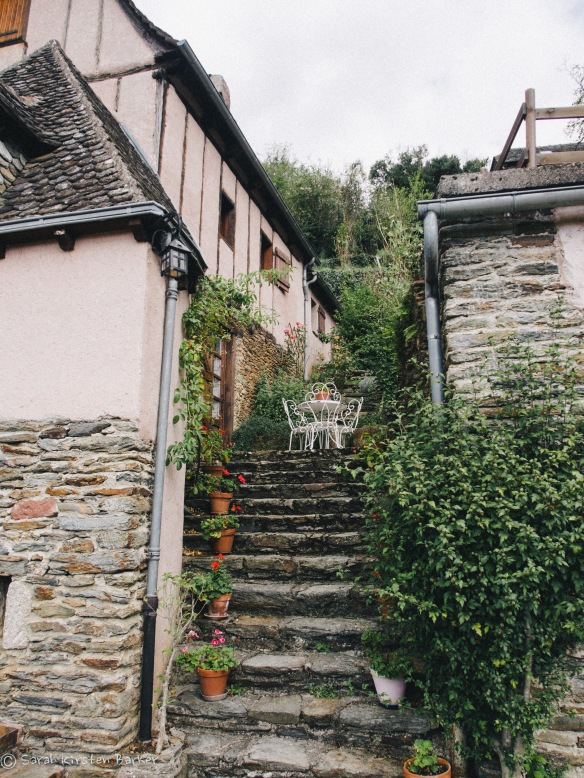For all intents and purposes the Lot Valley extends from its source at 1,272 metres on the slopes of the Montagne du Goulet in the east all the way down past Villeneuve-sur-Lot in the west. Nestled somewhere in the middle, approximately halfway between Figeac and Cahors, in the Quercy region, is the sleepy little hamlet Cajarc. A small village of approximatey 800 people whose dwellings have spread out from the original circle of its ramparts; north toward the imposing limestone cliffs and south toward the Lot itself into the flood plain. Where my parents bought a small house.
What a wonderful place to spend your retirement, wiling away the hours in a small courtyard garden, waging war on the fig tree and constructing large wooden shutters to ensure the windows make it through the winter without them.
A bonus of living so close to the river is that this view is only a few steps from the front door.
Though the flood heights from the previous centuries do worry me slightly.
During my time with them we covered a fair bit of ground around the Lot Valley, visiting sites such as Pech-Merle caves, Saint Cirq-Lapopie, Figeac, Villefranche-de-Rouergue and Conques. I’d call that quite a lot of ground covered.
As you travel east along the Lot, you go through the limestone with its caves apparent in the cliff faces, to sandstones and coals around a mining centre, into red sandstone and then into the schists and slates that help create the stunning gorges and narrow valleys between Capdenac and Entraygues Sur Truyere. Stunning countryside, this area is also home to Conques a small village and not so small abbey nestled on a steep hillside carved out by Le Dourdou.
Conques is an important staging point on a pilgrim route to St James of Compostela, and is the centre for the pilgrimage to Sainte Foy. Its name comes from the shape of the area, which looks remarkably like a conch shell or concha in Latin. The beginnings of the village were toward the end of the 8th century when a hermit Dadon chose the deserted spot to lead a life of contemplation. He quickly made some friends and a small community of Benedictine monks was established.
The current Romanesque abbey church is the third incarnation of the abbey in Conques and construction began in Conques’ golden age, from the middle of the 11th century to the first quarter of the 12th.
The first thing you see when you enter the church place is the tympanum over the eastern doorway. 124 figures represent the scene of the Last Judgement. This low relief sculpture measures 6.75 metres by 3.62 metres and features Christ the Judge as the central figure, surrounded by angels, demons, saints, notable persons from Conques’ history, as well as the gates to Heaven and Hell. A fair bit of artistic license was used by the sculptor, as well as bright colours to better impress the mind, many of which are still visible. It wasn’t until I got home and had a chance to read the guidebook and go through my photos that I could fully appreciate the fresco and true artistry that was involved in making it.
The abbey church of Sainte Foy is one of the great Romanesque pilgrim churches. Construction began in characteristic red sandstone between 1031 and 1065, however this material was soon deemed too fragile between 1065 and 1087. Construction continued using yellow limestone, which originates approximately twenty kilometres from Conques, with infill of the local grey schist. This can be seen quite well when looking up from the cloister toward the northern wall of the abbey.
Due to the local topography, the ground available for the abbey floorplan was limited and as a result the nave is much shorter than the transept. The nave was also much shorter than other abbeys in the area. As if to compensate for its shortcomings, the abbey has developed in height more than usual.
There is much fine artwork and craftwork around the abbey, from low relief sculptures of the Annunciation, to the 1995 Pierre Soulages stained glass windows, to the wrought iron gates around the choir. These are apparently one of the finest examples of Romanesque ironwork still preserved in France. The tops of the gates stem into either a flower shape or dragons heads.
Needless to say we spent quite a bit of time wandering the streets taking it all in and looking for the perfect photo opportunity. Dad even took it upon himself to become one with a hedge.
This was one of my favourite buildings of the day.
And wouldn’t this be a lovely spot for some lunch, if it weren’t 8 degrees outside. At least it was sunny I spose.
The village itself only dates back to the end of the Middle Ages however due to the topography and local materials available the village has achieved a sense of unity, irrespective of the period of construction. The principal country rock is schist, which was quarried on the spot and easily fashioned. It provided building stone, heavy stone shingles and paving for the street. Pink or grey standstones, and occasionally granite, was used to frame doors and windows.
On the way home we drove further up the Lot Valley and sped past some of the lovely gorges, bridges and communities that are all part of the wonderful tapestry that is the Lot Valley. What a lovely place to retire. I just feel a bit bad for the fig tree.













